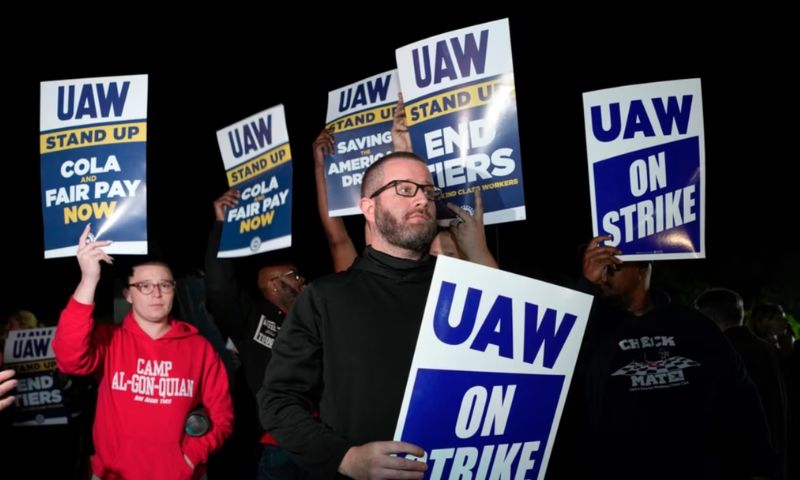MISSOURI: About 13,000 U.S. auto workers stopped production and went on strike Friday after their leaders failed to bridge a huge gap between union demands in contract negotiations and what Detroit’s three automakers are willing to pay.
Members of the United Auto Workers union began picketing at the General Motors assembly plant in Wentzville, Missouri, the Ford plant in Wayne, Michigan, near Detroit, and the Stellantis Jeep plant in Toledo, Ohio.
It was the first time in its 88-year history that the union walked out of all three companies at the same time, as the four-year contracts with those companies expired at 11:59 p.m. Thursday.
The strikes are likely to chart the future of the union and the U.S. domestic auto industry at a time when the U.S. workforce is straining and companies are facing a historic transition from making internal combustion cars to making electric vehicles.
If it lasts long, dealers could run out of vehicles and prices could rise. The walkout could even be a factor in next year’s presidential election by testing Joe Biden’s proud claim to be the most pro-union president in American history, according to France 24.
“Workers all over the world are watching,” said Liz Shuler, president of the AFL-CIO, a federation of 60 unions with 12.5 million members.
A different strike
The strike is markedly different from strikes during previous UAW negotiations. Instead of going after one company, the union, led by its combative new president, Shawn Fain, is striking all three. But not all of the UAW’s 146,000 members at the company’s plants are walking patrols, at least not yet.
Instead, the UAW targeted a handful of factories to get manufacturing company negotiators to raise their offers, which were well below the union’s demands for a 36% wage increase over four years. GM and Ford offered 20% and Stellantis, formerly Fiat Chrysler, offered 17.5%.
Outside a Ford plant in suburban Detroit, worker Britney Johnson, 35, who has worked for the company for about 3 1/2 years and won the union’s top pay, said she would like more pay, pensions reinstated and cost of living increases. “I like the job. We just deserve more,” she said.
Among the 400 or so workers on the picket line in Michigan was Adelisa LeBron, 37, who works on the engine line. She has been there for three years and makes $24 an hour as a junior employee, she said.
“The strike makes me nervous,” LeBron said. “I am a single mother of 3 teenagers. It’s important. With what I earn, I have to work part-time to make ends meet.’
The limited strikes will help preserve the union’s $825 million strike fund, which would dry up within 11 weeks if all 146,000 workers walk out. But Fain said more plants could be added if the companies don’t make better deals.
Even Fain called the union’s demands presumptuous, but says the automakers are raking in billions and can afford them. He scoffed at the company’s claims that the costly settlements would force them to raise vehicle prices, saying labor only accounts for 4-5% of vehicle costs.
“They could double our raises and not raise car prices and still make millions of dollars in profit,” Fain said. “We are not the problem. The problem is corporate greed.”
The strikes capped off a day with both sides griping that the other had not moved sufficiently from their original positions.
In addition to general wage increases, unions seek to restore cost-of-living increases, end differential wage levels for factory jobs, 32-hour workweeks with 40 hours of pay, restore traditional defined benefits. pensions for new hires who now only receive 401(k)-style pension plans, pension increases for retirees and other items.
Starting in 2007, workers waived cost-of-living increases and defined benefit pensions for new hires. The wage levels were created when the UAW tried to help companies avoid financial trouble before and during the Great Recession. Even so, only Ford avoided government-funded bankruptcy protection.
Many say it’s time to get the concessions back as companies make huge profits and CEOs collect millions. They also want to make sure unions represent workers at the shared electric vehicle battery factories the companies are building so workers have jobs building the vehicles of the future.
Workers at high-end assembly plants make about $32 an hour, plus big annual profit-sharing checks. Ford said the average annual wage, including overtime and bonuses, was $78,000 last year.
The Ford plant that is on strike employs about 3,300 workers and makes the Bronco SUV and Ranger midsize pickup trucks. The Toledo Jeep complex has about 5,800 employees and makes the Jeep Wrangler SUV and the Gladiator pickup truck. GM’s Wentzville plant has about 3,600 employees and makes the GMC Canyon and Chevrolet Colorado midsize pickup trucks, as well as the GMC Savana and Chevrolet Express full-size vans.
The union didn’t go after the companies’ big cash cows, which are full-size pickup trucks and large SUVs, and went instead to plants that make vehicles with lower profit margins, said Marick Masters, a business professor at Wayne State University in Detroit.
“They want to give companies some space without putting them up against a wall,” Masters said. “They don’t push them right into the corner. You corner an animal and it’s dangerous.”
Automakers say they are facing unprecedented demands as they develop and manufacture new electric vehicles while producing gas-powered cars, SUVs and trucks to pay the bills. They fear that labor costs will rise so much that they will have to price their cars above those sold by foreign automakers with factories in the US.























